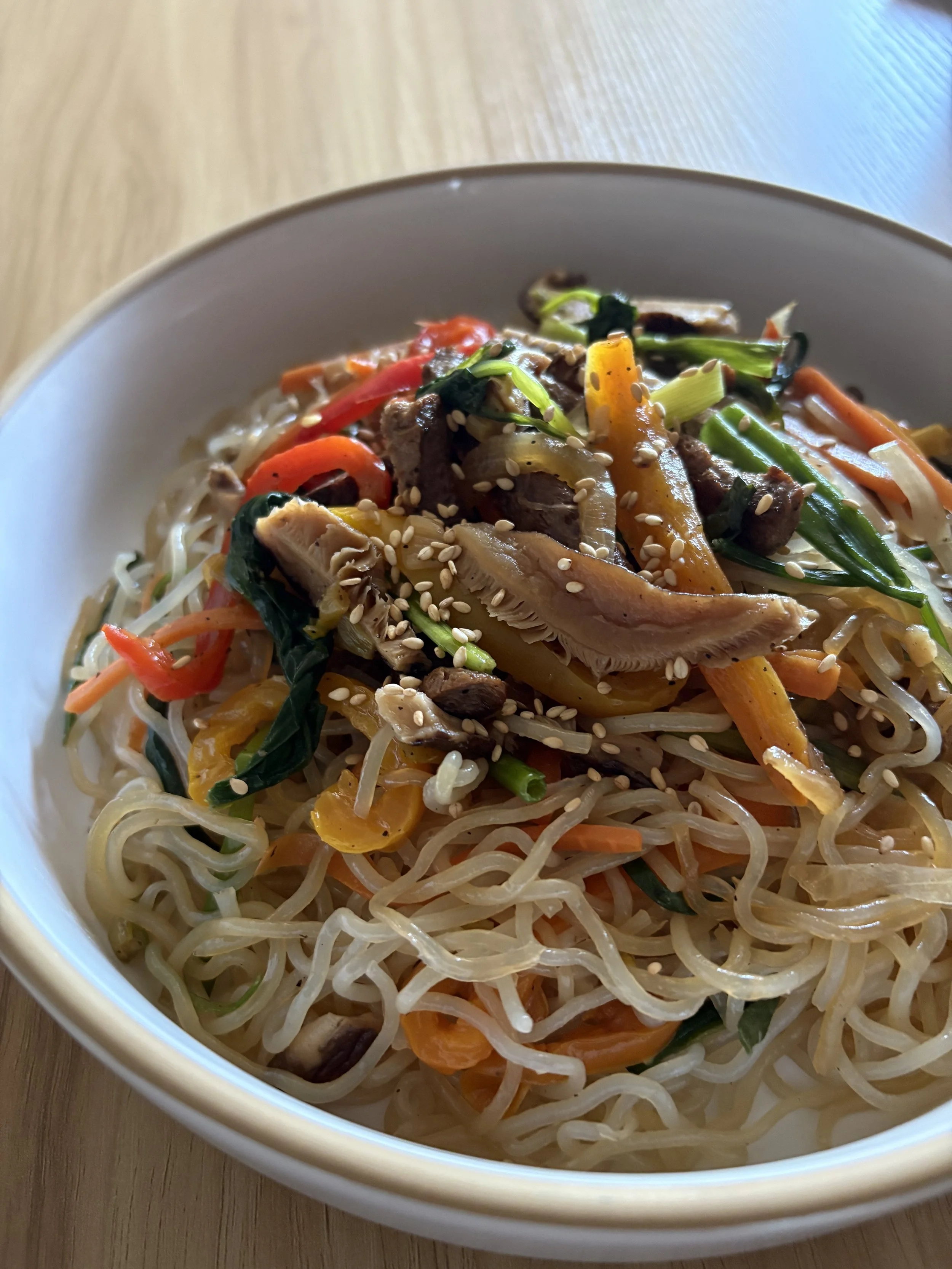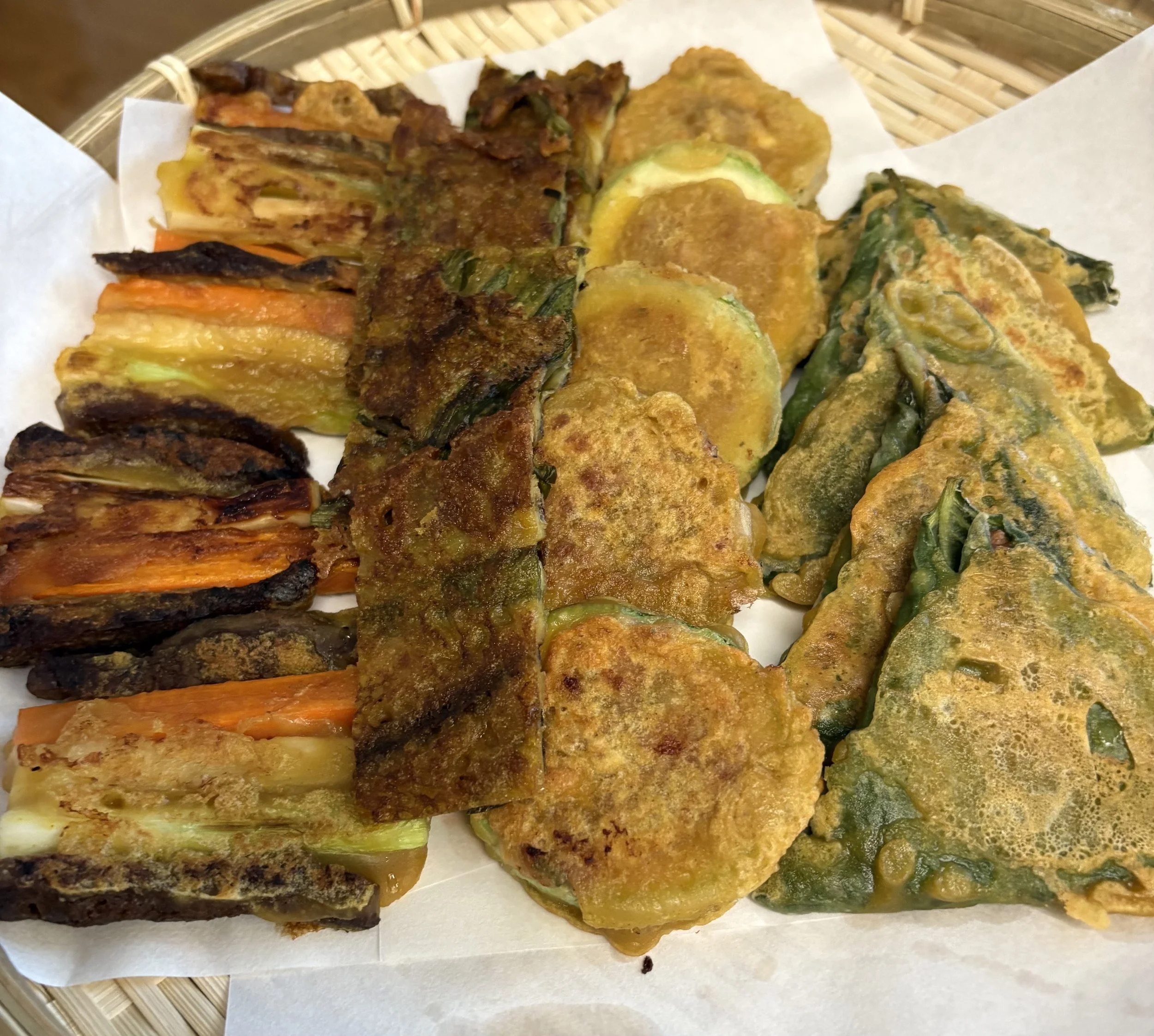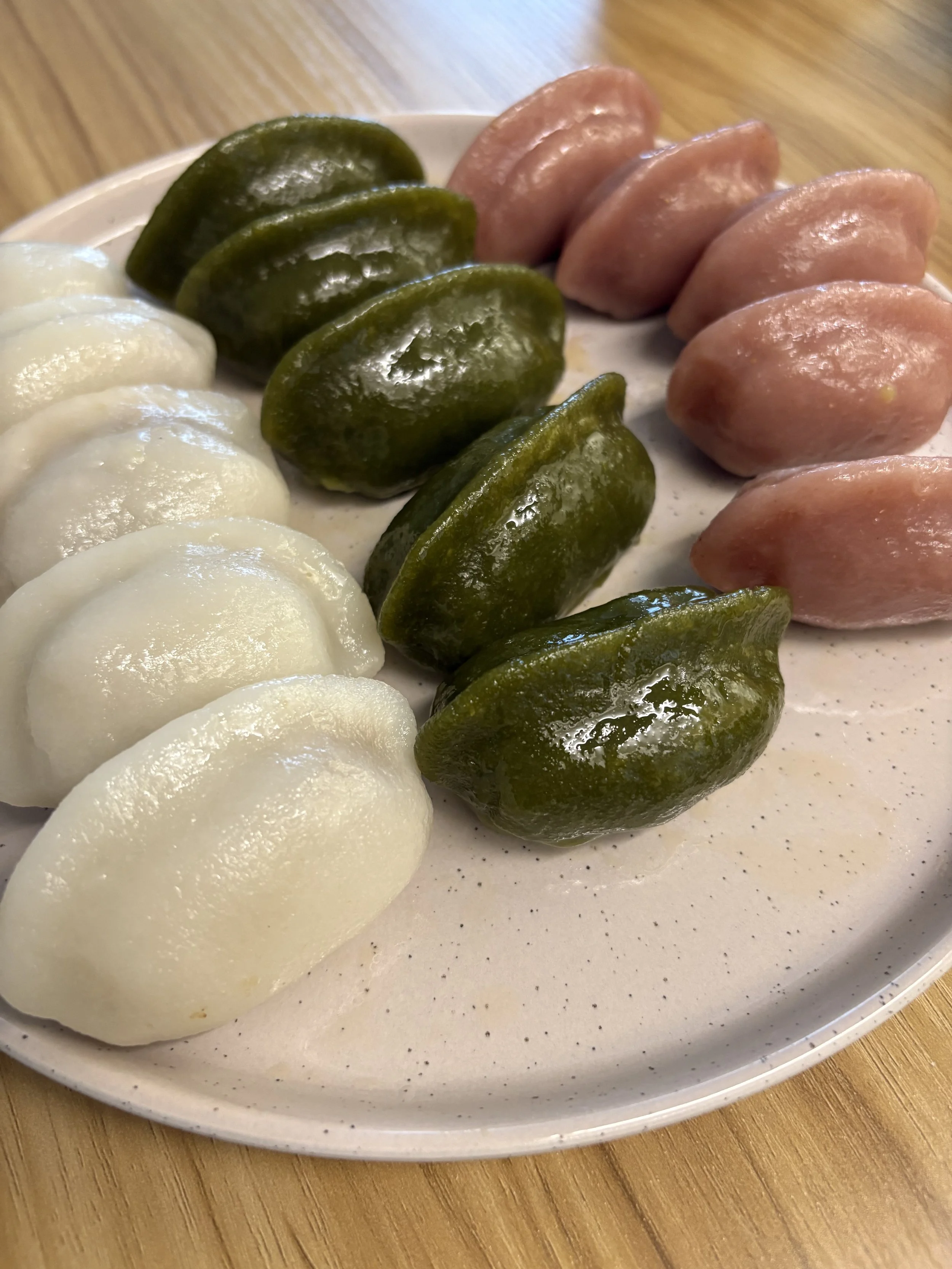OCTOBER SPECIAL - CHUSEOK RECIPES
By Justine Valesquez
For a few years now, I have loved experimenting on plant-based versions of classic Korean dishes at home. Ever since I got into Korean cuisine, I have thought about preparing my very own 추석 (Chuseok) holiday feast. I decided to take on the challenge for this year’s 추석. I know there are already a multitude of delicious traditional 추석 recipes written by experienced cooks which are readily available to anyone with Internet access. I definitely could not hold a candle to these seasoned experts who have taken years to develop their craft. In fact, I heavily rely on their expertise as I build my own 추석 feast. With their help, I am trying my hand at re-interpreting Korean traditional holiday classics: 잡채, 전, and 송편.
잡채 (japchae)
The first dish is 잡채 (japchae). This is a quintessential Korean holiday dish. The name 잡채 itself means “mixed vegetables” as 잡 means “to mix” and 채 means “vegetables.” Originally served to royalty and high-level officials during the Joseon Dynasty without the noodles, 잡채 only started including the glass noodles in the 20th century. As it is known today, it contains seasoned 당면 (dangmyeon - sweet potato glass noodles) with various mix-ins, including vegetables, shiitake mushrooms, and sometimes meat.
My interpretation of 잡채 is inspired by the recipe from The Korean Vegan cookbook by Joanne Lee Molinaro.
Ingredients:
1 carrot
1/2 yellow bell pepper
1/2 red bell pepper
1/2 onion
2 scallions
4 small cloves of garlic
2 cups spinach
1/2 cup of sliced, dried shiitake mushrooms, or 1 cup of fresh shiitake mushrooms
20 pieces of Trader Joe’s frozen Korean beefless bulgogi (optional)
250 g sweet potato glass noodles
8 tbsp soy sauce
5 tbsp sesame oil
3 tbsp agave syrup (or any other sweetener of choice)
Neutral cooking oil of choice (for sautéing/stir frying)
Salt and pepper to taste
Directions:
Soak the noodles for 15 minutes.
Thaw the beefless bulgogi. Once thawed, slice into thin strips.
Soak the sliced, dried shiitake mushrooms in hot water for 30 minutes then drain thoroughly.
Blanche spinach in hot water for about 1 minute or until it turns bright green. Then soak in cold water. Once cooled, drain the spinach thoroughly.
Peel the carrot and the onion. Then slice into long and thin pieces (about 2 inches long).
Slice bell peppers and scallions into long and thin pieces (about 2 inches long).
Mince the garlic.
Place a pan over medium heat and add about 2 tbsp cooking oil once heated.
Sauté carrots and add salt and pepper. Once sautéed, transfer to a bowl.
Add more oil as needed, then sauté the bell peppers and add salt and pepper. Once sautéed, transfer to the same bowl as the carrots.
Add more oil as needed, then sauté the mushrooms and add salt and pepper. Once sautéed, transfer to the same bowl as the carrots and bell peppers.
Add more oil as needed, then sauté the onion and white parts of the scallions until fragrant and translucent.
Add the minced garlic and finish sautéing. Once sautéed, transfer onions and garlic to the same bowl as everything else.
Stir fry the beefless bulgogi strips until heated through.
Combine the sautéed vegetables, blanched spinach, mushrooms, and stir fried beefless bulgogi into a big bowl.
Add 3 tbsp of soy sauce, 2 tbsp of sesame oil, and 1 tbsp of agave syrup then mix.
Boil noodles for 3 minutes, then soak in cold water to stop cooking. Drain thoroughly.
Mix the remaining soy sauce, sesame oil, and agave syrup and add to noodles, then mix until the noodles are fully coated.
Add the vegetables, mushrooms, and beefless bulgogi to the noodles. Top with the green parts of the scallions and sesame seeds. Can be served immediately or made ahead of time.
전 (jeon)
The second dish is 전 (jeon). 전 is another Korean holiday staple (and a staple in general Korean cuisine). 전 is a savory fritter; various ingredients are coated in flour, coated in egg wash, and pan fried in oil. This special dish has been present in Korean cuisine for a very long time. There are records from the Goryeo dynasty indicating a cooking method that is similar to how 전 is made today. This dish became prevalent in royal banquets during the Joseon Dynasty. Since then, it has been considered a versatile food, from being a popular dish eaten while drinking alcohol (i.e. 안주 (anju)) to being a part of ancestral rites (i.e. 차례 (charye)) during 추석. I am making four types: 파전 (pajeon), 깻잎전 (kkaennipjeon), 호박전 (hobakjeon), and 꼬치전 (kkochijeon). Because I am trying to create a plant-based version of this dish, I had to come up with an alternative to the egg wash.
I referred to Maangchi‘s and Korean Bapsang’s 전 recipes as starting points for my own 전 interpretations.
Ingredients:
Batter (Used for the all types of 전):
2 cups all-purpose flour
2 tbsp potato starch
4 tsp Turmeric (adds a yellow color characteristic of egg batters)
4 tsp kala namak a.k.a. black salt (adds a hint of egg-like flavor) (optional)
4 tbsp soy sauce
4 tbsp garlic powder
1 tbsp cane sugar
파전 (scallion pancake) (makes 1 pancake):
1/2 serving of batter
6-8 scallions
Neutral cooking oil of choice (for pan frying)
깻잎전 (stuffed perilla leaf fritter) (makes 10 fritters):
10 perilla leaves (pick the larger ones)
120 g of vegan ground beef (I use Beyond for this recipe)
1 scallion
2 cloves of garlic
1/8 onion
1/4 cup of dried sliced shiitake mushrooms
1/4 carrot
1 tbsp soy sauce
1 tbsp sesame oil
1/4 tbsp cane sugar
1/4 cup all-purpose flour
1/2 serving of batter
Neutral cooking oil of choice (for pan frying)
호박전 (Korean squash fritter) (makes 10 fritters):
1-2 Korean squashes or zucchini (depending on length)
1/4 cup all-purpose flour
1/2 serving of batter
Neutral cooking oil of choice (for pan frying)
꼬치전 (pan-fried skewers) (makes 10 fritters):
10 large pieces Trader Joe’s beefless bulgogi (sliced thinly) or about 1/2 block of extra firm tofu
4 scallions
3 King Oyster mushrooms
2 carrots
10 bamboo skewers
Neutral cooking oil of choice (for pan frying)
Directions:
Batter Directions:
Mix all ingredients in a large bowl.
Add cold water in 1 tbsp increments until the batter is a bit thick but still runny (like a breakfast pancake batter).
Keep mixing until the batter is completely smooth and without any lumps.
파전 Directions:
Cut off the roots of the scallions.
Slice the scallions in half.
In a bowl, add the scallions and coat them completely in the batter.
Place a pan over medium heat and add about 2 tbsp cooking oil once heated.
Add the scallions coated in batter to the pan and arrange scallions in a single layer.
Cook for about 3-5 minutes on each side, periodically checking to make sure it has not browned too much and it does not stick to the pan.
Once both sides are golden brown, turn off the heat. Best served immediately.
깻잎전 Directions:
Soak the dried sliced shiitake mushrooms in hot water for 30 minutes. Drain thoroughly then dice finely.
Slice the scallions thinly.
Peel and dice the carrots and onions finely.
Mince the garlic.
Add plant-based ground beef to a bowl.
Add mushrooms, scallions, carrots, onions, and garlic, then mix well.
Season with soy sauce, sesame oil, and cane sugar then mix again.
Wash the perilla leaves in cold water and shake off excess.
Without letting it dry, coat a perilla leaf in all-purpose flour on each side.
Hold the perilla leaf in the palm of your hand top side down with the pointy tip of the leaf pointing towards the fingertips.
Add 1/2 tbsp of the ground beef filling and spread thinly on the leaf.
Fold each of the two round bottoms of the leaf over the filling to make a pointy tip on the bottom end of the leaf.
Fold the whole leaf in half with the filling inside, bringing the bottom end and the top ends of the leaf together. This will create a triangle shape.
Dredge in all-purpose flour.
Coat in batter and shake off excess.
To a pan over medium heat with 2 tbsp of cooking oil, add the coated stuffed perilla leaf.
Cook for about 3-5 minutes on each side, periodically checking to make sure it has not browned too much and it does not stick to the pan.
Once both sides are golden brown, turn off the heat. Best served immediately.
호박전 Directions:
Slice Korean squashes or zucchinis into 1/4 inch rounds (there may be some left over depending on the length of the Korean squashes/zucchinis).
Place a pan over medium heat and add about 2 tbsp cooking oil once heated.
Dredge in all-purpose flour.
Coat in batter and shake off excess.
Cook for about 3-5 minutes on each side, periodically checking to make sure it has not browned too much and it does not stick to the pan.
Once both sides are golden brown, turn off the heat. Best served immediately.
꼬치전 Directions:
Thaw the beefless bulgogi. Once thawed, slice in half lengthwise. If using tofu, drain and press for at least 15 minutes then slice into 4-inch long and 1/4 inch width strips.
Stir fry the beefless bulgogi until heated through.
Slice the carrots into 4-inch long and 1/4-inch width strips and microwave in 30-second increments until tender and bendy.
Slice King Oyster mushrooms into 4-inch long and 1/4-inch width strips.
Slice off the softer green tips of the scallions and slice the light green and white sections into 4-inch long and 1/4-inch width strips.
Skewer the strips towards the end of the strip, about 1/8 of an inch in. The order of the skewer is as follows:
1 strip of beefless bulgogi
1 strip of scallion
1 strip of King Oyster mushroom
1 strip of carrot
1 strip of beefless bulgogi
Place a pan over medium heat and add about 2 tbsp cooking oil once heated.
Dredge in all-purpose flour.
Coat in batter and shake off excess.
Add to pan. Spoon a little bit more batter over any gaps in between the strips (especially around the beefless bulgogi and scallion).
Cook for about 3-5 minutes on each side, periodically checking to make sure it has not browned too much and it does not stick to the pan.
Once both sides are golden brown, turn off the heat. Trim to make the edges straighter, if desired. Best served immediately.
송편 (songpyeon)
Last but definitely not least is 송편 (songpyeon). This rice cake with a sweet filling is a main staple during 추석. Like 잡채 and 전, it has deep roots in Korean history. It was a dish to celebrate the harvest. Per historical records, 송편 became widely practiced during the Goryeo dynasty. As for the traditional shape, which is similar to a half moon, there are different common beliefs. One of them is that a full moon can only wane while a half moon is on its way to being full, so this shape is symbolic of prosperity. Some typical fillings are sesame seeds, red beans, and mung beans sweetened with sugar and honey. There are also many variations among different regions in Korea.
I used Maangchi’s method for making 맵쌀가루 (maepssalgaru - non-glutinous short grain rice flour). My 송편 interpretation is a modified, plant-based version of Korean Bapsang’s recipe. Traditionally, 송편 is steamed on a bed of pine needles, but that is not easily accessible to me. For coloring the dough, I wanted to use ingredients that are more easily accessible for me as well. For assembling 송편, I used Beyond Kimchee’s visual diagram as a reference.
Ingredients:
Dough:
White (makes 4 pieces):
117 g rice flour
3-4 tbsps boiling water
Green (makes 4 pieces):
117 g rice flour
1.5 tbsp sweetened matcha powder
4-5 tbsps boiling water
Light pink (makes 4 pieces):
117 g rice flour
2 tbsps finely ground freeze dried strawberries
4-5 tbsps boiling water
Filling:
1/3 cup toasted sesame seed
1.5-2 tbsp maple syrup
1 tbsp cane sugar
1/4 tsp salt
Directions:
Sift rice flour through a fine mesh sieve into a bowl.
For the colored dough, sift sweetened matcha powder/freeze dried strawberries powder into the same bowl. Whisk to incorporate the flour and powder.
Boil some water and add it to the flour in 1/2 tbsp increments. Mix in between adding the water. Keep adding water and mixing until the dough reaches the right consistency. Note: The amount of water in the ingredients list should be taken as an estimate rather than a strict measurement. You just have to feel the dough to determine if it’s too wet (sticking to your hands/bowl/spatula) or too dry (crumbling). It’s got to be the perfect Play Dough consistency before it’s ready for the next step.
Rest the dough for 30 minutes.
While the dough is resting, make the filling by coarsely grinding toasted sesame seeds in a blender/food processor/coffee grinder and mix in maple syrup, cane sugar, and salt.
Once rested, split the dough into 4 equal parts.
Roll the dough into a ball and flatten into a bowl-like shape.
Add about 1/2 tbsp of filling in the middle of the dough bowl.
Fold the dough in half over the filling and pinch the seam closed to secure the feeling inside.
Lightly squeeze the dough and roll into a cylindrical shape.
Pinch from end to end to create a rounded edge.
Steam for 20 minutes. Add pine needles to the bottom of the steam basket if desired.
Once done steaming, coat with sesame oil. If steaming with pine needles, rinse in cold water to wash off any potential debris before coating in sesame oil.
Best served immediately.



